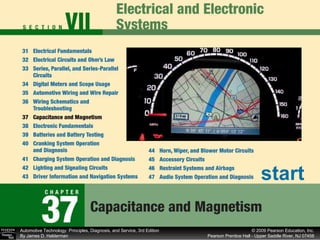Denunciar
Compartilhar

Recomendados
Recomendados
Mais conteúdo relacionado
Mais procurados
Mais procurados (20)
High performance fast charging of electric vehicles

High performance fast charging of electric vehicles
Lead-Acid Battery Simplified Simulink Model using MATLAB 

Lead-Acid Battery Simplified Simulink Model using MATLAB
Semelhante a Chapter 37
Semelhante a Chapter 37 (20)
Class 12th Physics Project File (Capacitors) 23-24

Class 12th Physics Project File (Capacitors) 23-24
Mais de mcfalltj
Mais de mcfalltj (20)
Último
Último (20)
Boost Fertility New Invention Ups Success Rates.pdf

Boost Fertility New Invention Ups Success Rates.pdf
Workshop - Best of Both Worlds_ Combine KG and Vector search for enhanced R...

Workshop - Best of Both Worlds_ Combine KG and Vector search for enhanced R...
[2024]Digital Global Overview Report 2024 Meltwater.pdf![[2024]Digital Global Overview Report 2024 Meltwater.pdf](data:image/gif;base64,R0lGODlhAQABAIAAAAAAAP///yH5BAEAAAAALAAAAAABAAEAAAIBRAA7)
![[2024]Digital Global Overview Report 2024 Meltwater.pdf](data:image/gif;base64,R0lGODlhAQABAIAAAAAAAP///yH5BAEAAAAALAAAAAABAAEAAAIBRAA7)
[2024]Digital Global Overview Report 2024 Meltwater.pdf
Tata AIG General Insurance Company - Insurer Innovation Award 2024

Tata AIG General Insurance Company - Insurer Innovation Award 2024
08448380779 Call Girls In Civil Lines Women Seeking Men

08448380779 Call Girls In Civil Lines Women Seeking Men
Scaling API-first – The story of a global engineering organization

Scaling API-first – The story of a global engineering organization
TrustArc Webinar - Stay Ahead of US State Data Privacy Law Developments

TrustArc Webinar - Stay Ahead of US State Data Privacy Law Developments
Strategies for Unlocking Knowledge Management in Microsoft 365 in the Copilot...

Strategies for Unlocking Knowledge Management in Microsoft 365 in the Copilot...
Understanding Discord NSFW Servers A Guide for Responsible Users.pdf

Understanding Discord NSFW Servers A Guide for Responsible Users.pdf
What Are The Drone Anti-jamming Systems Technology?

What Are The Drone Anti-jamming Systems Technology?
The Codex of Business Writing Software for Real-World Solutions 2.pptx

The Codex of Business Writing Software for Real-World Solutions 2.pptx
08448380779 Call Girls In Friends Colony Women Seeking Men

08448380779 Call Girls In Friends Colony Women Seeking Men
The Role of Taxonomy and Ontology in Semantic Layers - Heather Hedden.pdf

The Role of Taxonomy and Ontology in Semantic Layers - Heather Hedden.pdf
Chapter 37
- 1. start
- 8. DIELECTRIC CONSTANTS Continued See the chart on Page 382 of your textbook.
- 11. Figure 37–3 As the capacitor charges, the battery forces electrons through the circuit. Figure 37–4 When the capacitor is charged, there is equal voltage across the capacitor and the battery. An electrostatic field exists between the capacitor plates. No current flows in the circuit. Continued
- 23. Magnets are commonly used in vehicle crankshaft, camshaft, and wheel speed sensors. If a magnet is struck and cracks or breaks, the result is two smaller-strength magnets. Because the strength of the magnetic field is reduced, the sensor output voltage is also reduced. A typical problem occurs when a magnetic crankshaft sensor becomes cracked, resulting in a no-start condition. Sometimes the cracked sensor works well enough to start an engine that is cranking at normal speeds but will not work when the engine is cold. A Cracked Magnet Becomes Two Magnets Figure 37–11 If a magnet breaks or is cracked, it becomes two weaker magnets.
- 27. A piece of steel can be magnetized by rubbing a magnet in one direction along the steel. This causes the atoms to line up in the steel, so it acts like a magnet. Steel often won’t remain magnetized, while a true magnet is permanently magnetized. When soft iron or steel is used, such as a paper clip, it will lose its magnetism quickly. The atoms in a magnetized needle can be disturbed by heating it or by dropping the needle on a hard object, which would cause the needle to lose its magnetism. Soft iron is used for ignition coils because it will not keep its magnetism. Magnetize a Steel Needle
- 44. Figure 37–25 Voltage can be induced by the relative motion between a conductor and magnetic lines of force. Voltage Strength Voltage is induced when a conductor cuts across magnetic flux lines. The amount of the voltage depends upon the rate at which flux lines are broken. The more flux lines broken per unit of time, the greater the induced voltage. If a single conductor breaks one million flux lines per second, one volt is induced. The motion can be a conductor moving across a magnetic field or a field moving across a stationary conductor (as in AC generators and ignition coils). In both cases, induced voltage is generated by relative motion between the conductor and the magnetic flux lines. Continued
- 46. Figure 37–26 No voltage is induced if the conductor is moved in the same direction as the magnetic lines of force (flux lines). Figure 37–27 Maximum voltage is induced when conductors cut across the magnetic lines of force (flux lines) at a 90-degree angle. Continued
- 55. Figure 37–30 Typical air-cooled epoxy-filled E coil.
- 66. A cell (cellular) phone emits a weak signal if it is turned on, even though it is not being used. This signal is picked up and tracked by cell phone towers. When the cell phone is called, the cell phone emits a stronger signal to notify the tower that it is on and capable of receiving a phone call. It is this “handshake” signal that can cause interference in the vehicle. Often this signal simply causes some static in the radio speakers even though the radio is off, but it can also cause a false antilock brake (ABS) trouble code to set. These signals from the cell phone create a voltage that is induced in the wires of the vehicle. Because the cell phone usually leaves with the customer, the service technician is often unable to verify the customer concern. Remember, the interference occurs right before the cell phone rings. To fix the problem, connect an external antenna to the cell phone. This step will prevent the induction of a voltage in the wiring of the vehicle. Cell Phone Interference
- 69. end